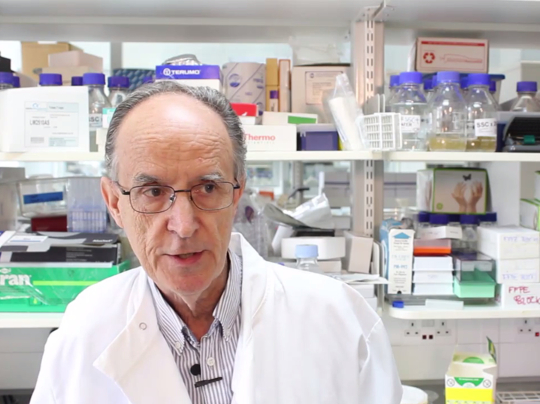
Professor Mel Greaves
No child should have to suffer cancer.
But 1 in 2000 children – or 500 a year – in the UK will develop a type of cancer called acutelymphoblastic leukaemia (ALL) by the time they are 15 years old.
ALL is the most common cause of cancer in children and it develops in immune cells in the bone marrow, when these cells don’t mature properly and grow too fast.
Around 90% of children who are diagnosed with ALL can be successfully treated with a combination of chemotherapies. But the side effects can be severe and lifelong, and for the remaining 10% there aren't many more treatment options.
Since its discovery more than 100 years ago, the cause of ALL has led to a lot controversy. Many theories – some possible, some peculiar – have been put forward, but none have stood up to close scrutiny...
Until now.
World-leading scientist, Professor Mel Greaves, who is Director of the Centre of Evolution and Cancer at The Institute Of Cancer Research, London, has published the most comprehensive body of evidence yet, which not only reveals the most likely cause of ALL, but also that it could be preventable.
Leading UK scientist reveals likely cause of childhood leukaemia — read the associated news item to find out more about this story.
What causes childhood ALL?
Professor Greaves has found the disease develops in two steps.
The first step is a genetic mutation before birth, as a baby grows in the womb. But parents shouldn't be unduly worried. This mutation occurs at random in as many as 1 in 20 babies, and 99% of children who carry this early mutation do not go on to get leukaemia.
That means only 1% of children who carry the mutation go on to get leukaemia, so there must be something else going on.
The second step is crucial. Professor Greaves and colleagues have now shown that a second gene mutation occurs later in childhood and that it is triggered when children with the initial mutation (from step 1) fall ill with common infections, such as flu or other common viruses.
BUT, and it is a big 'but', this only happens in children who experienced 'clean' childhoods in the first year of life, without much interaction with other infants or older children.
Why should hygiene and playtime be so important in very young children, before they are even one year old?
Educating the immune system
It turns out our immune system need to be properly ‘educated’ early in life so it knows the correct way to respond to infection. The immune system needs to be challenged by different ‘bugs’ – such as bacteria, viruses, parasites and fungi – in order to set up the right connections between molecules and cells that make up the complex network that is essential for normal immune responses with regulatory checks.
If we don't prime our immune systems in this way, it means when we are challenged by an infection later in life, our immune cells might not react in the right way, and the response to the infection is over-the-top, and can last too long.
With ALL, it turns out this can lead to a mutations in immune cells that mean they multiply too quickly and become cancerous.
This theory is known amongst scientists as the 'delayed infection hypothesis' and has been shown to be the cause of other diseases as well – such as type I diabetes, other autoimmune disease and many allergies.
Our latest research shows that within the next decade, we can make acute lymphoblastic leukaemia preventable. Your support will help us make this disease a thing of the past.
Find out more
Preventing ALL – what should parents do?
So the idea that people in developed countries like the UK are a bit too clean isn't itself new. But it does give us a huge clue for how to prevent leukaemia.
Professor Greaves believes naturally occurring bacteria – such as those found in a probiotic, those that children might be exposed to playing with other children – might be able to prime a child's immune system in the right way so they never go on to develop leukaemia.
But before parents run to the fridge to dig out that probiotic yogurt they bought in the supermarket at the weekend – STOP! Professor Greaves, and colleagues around the world, first have to test if a probiotic would help prevent leukaemia, they need to work out which naturally bacteria are most effective, and what is the best way to deliver it to babies. This could take 5–10 years.
In the meantime, there are some steps you can take that could reduce the risk of childhood leukaemia – such as try not to be over-zealous with hygiene and make sure that kids get to play with other children so they can share harmless bugs.
What does the future hold for childhood ALL?
The cause revealed by Professor Greaves is backed up by 30 years of detailed research in cells and animals in the lab, genetics, immunology research, twin studies and population studies.
Although very little in science is said with 100% certainty, Professor Greaves believes there is little doubt that the majority of cases of leukaemia are caused by this two-step process – genetic mutation before birth then a second later in childhood, triggered by infection in children with immune systems that weren't primed in the first year of life.
Professor Greaves said:
“I have spent more than 40 years researching childhood leukaemia, and over that time there has been huge progress in our understanding of its biology and its treatment – so that today around 90 per cent of cases are cured. But it has always struck me that something big was missing, a gap in our knowledge – why or how otherwise healthy children develop leukaemia and whether this cancer is preventable.
“This body of research is a culmination of decades of work, and at last provides a credible explanation for how the major type of childhood leukaemia develops. The research strongly suggests that ALL has a clear biological cause, and is triggered by a variety of infections in predisposed children whose immune systems have not been properly primed. It also busts some persistent myths about the causes of leukaemia, such as the damaging but unsubstantiated claims that the disease is commonly caused by exposure to electro-magnetic waves or pollution.”
Professor Greaves is also backed up by ever-mounting evidence that suggests the lifestyles we live in developed societies are leading to a wave of new chronic diseases that aren’t found in other parts of the world. The incidence of allergies, autoimmune diseases and many types of cancer are on the increase in developed countries, whereas some don’t exist at all in developing countries.
Final piece of the puzzle
It takes a very long time to gather this level of evidence – to conduct all the needed experiments, and put all the pieces of the puzzle together. The last piece of the puzzle now will be to prove you can prevent leukaemia.
Looking to the future, Professor Greaves said:
“I hope this research will have a real impact on the lives of children. The most important implication is that most cases of childhood leukaemia are likely to be preventable. It might be done in the same way that is currently under consideration for autoimmune disease or allergies – perhaps with simple and safe interventions to expose infants to a variety of common and harmless bugs.”
Hopefully, in the next 5–10 years, we will be in a position to prevent the majority of cases of the most common childhood cancer and spare children and their families the trauma of a diagnosis with acute lymphoblastic leukaemia.
